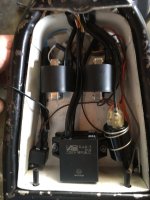I understand what your saying..........visually things should change if the sprockets change size.
Doesn't in reality............the time it takes for the crank to travel one revolution, also is the same time a sprocket takes to travel one revolution. Doesn't matter what size, the front sprocket could be 100 teeth and the outside of the sprocket still takes the same time to do one revolution. ........as long as the two sprockets retain the ratio of 2:1 then the bike travels the same speed.
Here is where it can confuse.........the speed of the out side of the sprocket changes with different sizes.........it takes the same time for a 16 tooth sprocket to do one revolution, (crank revolution), as a 100 tooth sprocket, but the sprocket at the teeth, (one tooth), will be traveling faster to complete the revolution.......it has further to travel.
To put it another way. The circumference changes with the size of the sprocket............it takes the same time to do one revolution of the crank shaft as it does at the teeth of the sprocket......... the speed one tooth takes to do a revolution of the circumference increases as the size of the sprocket increases.........
again, as long as the ratio stays the same..... the speed/revolution transfer at the crank shaft to the rear wheel speed/revolution stays the same.......changing the amount of teeth on either of the sprockets, (change the ratio), will either increase or decrease the speed of a tooth doing one revolution. One tooth more on the front and the time it takes the tooth to do one revolution speeds up......the chain is traveling faster......this is transferred to the rear sprocket/wheel, (as long as the rear sprocket stays the same)
The crank is the constant


